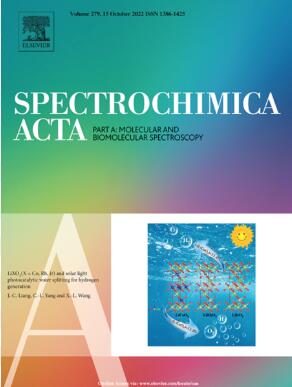Dual-channel fluorescent probe for simultaneous monitoring of polarity and viscosity in live-cell nucleus and sewage water
IF 4.3
2区 化学
Q1 SPECTROSCOPY
Spectrochimica Acta Part A: Molecular and Biomolecular Spectroscopy
Pub Date : 2025-06-26
DOI:10.1016/j.saa.2025.126616
引用次数: 0
Abstract
Nuclear polarity and viscosity are critical for maintaining proper nuclear function, including gene expression and chromatin organization. Disruptions in these physical properties can lead to impaired nuclear transport and altered signaling pathways, which are linked to diseases such as cancer and neurodegenerative disorders. We have designed a naphthalimide-based fluorescent “rotor” capable of sensing both viscosity and polarity. Interestingly, the probe Nu-PV exhibited an emission peak at 525 nm in the nonpolar solvent dioxane while in contrast, it displayed a red-shifted emission maximum at 602 nm in environments with high viscosity (glycerol). The probe is chemically stable, non-reactive with other analytes, and non-toxic. It detected changes in viscosity and polarity across various chemical industry samples. It selectively detects the nonpolar components within the nucleus and has shown that nuclear polarity decreases under conditions such as oxidative stress, starvation, and apoptosis. This suggests that probe Nu-PV can effectively monitor changes in nuclear polarity during disease-related states, potentially aiding in the development of treatments to address cellular abnormalities.

双通道荧光探针同时监测活细胞核和污水的极性和粘度
核极性和黏度是维持正常核功能的关键,包括基因表达和染色质组织。这些物理特性的破坏可导致核转运受损和信号通路改变,这与癌症和神经退行性疾病等疾病有关。我们设计了一种基于萘酰亚胺的荧光“转子”,能够感应粘度和极性。有趣的是,探针Nu-PV在非极性溶剂二氧六烷中表现出525 nm的发射峰,而在高粘度环境(甘油)中表现出602 nm的红移发射峰。该探针具有化学稳定性,不与其他分析物发生反应,并且无毒。它检测了各种化学工业样品的粘度和极性的变化。它选择性地检测细胞核内的非极性成分,并表明核极性在氧化应激、饥饿和细胞凋亡等条件下降低。这表明探针Nu-PV可以有效地监测疾病相关状态期间核极性的变化,可能有助于开发治疗细胞异常的方法。
本文章由计算机程序翻译,如有差异,请以英文原文为准。
求助全文
约1分钟内获得全文
求助全文
来源期刊
CiteScore
8.40
自引率
11.40%
发文量
1364
审稿时长
40 days
期刊介绍:
Spectrochimica Acta, Part A: Molecular and Biomolecular Spectroscopy (SAA) is an interdisciplinary journal which spans from basic to applied aspects of optical spectroscopy in chemistry, medicine, biology, and materials science.
The journal publishes original scientific papers that feature high-quality spectroscopic data and analysis. From the broad range of optical spectroscopies, the emphasis is on electronic, vibrational or rotational spectra of molecules, rather than on spectroscopy based on magnetic moments.
Criteria for publication in SAA are novelty, uniqueness, and outstanding quality. Routine applications of spectroscopic techniques and computational methods are not appropriate.
Topics of particular interest of Spectrochimica Acta Part A include, but are not limited to:
Spectroscopy and dynamics of bioanalytical, biomedical, environmental, and atmospheric sciences,
Novel experimental techniques or instrumentation for molecular spectroscopy,
Novel theoretical and computational methods,
Novel applications in photochemistry and photobiology,
Novel interpretational approaches as well as advances in data analysis based on electronic or vibrational spectroscopy.

 求助内容:
求助内容: 应助结果提醒方式:
应助结果提醒方式:


